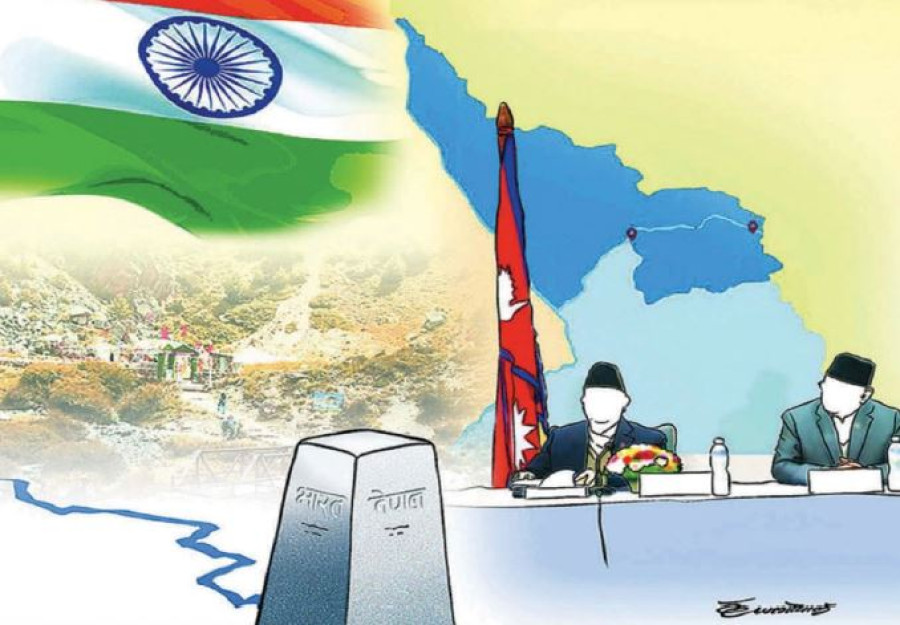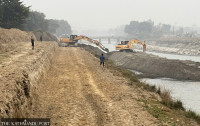National
Nepal has twice asked India for talks on border, other than Kalapani and Susta, but it has not responded, officials say
Boundary Working Group was formed in 2014 and has been meeting every year since. Discontinuity of meetings could lead to complexities, experts say.
Anil Giri
Despite Nepal’s repeated calls to India to hold this year’s meeting of the Boundary Working Group, New Delhi has not responded, although the latest high level visit of the Indian army chief Manoj Mukund Naravane indicated that bilateral ties are heading towards normalcy.
The Boundary Working Group, a mechanism formed in 2014, has been meeting every year since its inception and is mandated to resolve boundary issues except those related to Kalapani and Susta, the two most controversial border flash points.
Officials familiar with the issue told the Post that Nepal proposed holding a meeting in October. But as there was no response from New Delhi, it has now proposed the end of November as an alternative date.
“We proposed two dates to India to hold the meeting of BWG, but we are yet to get a response. We have been waiting since August for the confirmation of dates,” an official of the Ministry of Foreign Affairs, told the Post on the condition of anonymity.
The meeting generally takes place in August every year.
Officials from the Ministry of Land Management, Cooperatives and Poverty Alleviation, Department of Survey under it and the Ministry of Foreign Affairs take part in the meeting.
But the Ministry of Land Management is unaware of the progress regarding the dates of the talks, according to ministry spokesman Janak Raj Joshi.
“Maybe the Ministry of Foreign Affairs and Department of Survey might know about it,” Joshi told the Post.
The Boundary Working Group is mandated to seek an amicable technical solution to unsettled boundary rows, including addressing border encroachment problems, reinstating missing border pillars and repairing damaged ones and clearing the no man’s land between Nepal and India, among other things.
During the same meeting in 2014, the two foreign secretaries of Nepal and India were also told to take technical inputs from BWG to resolve the boundary dispute in Kalapani and Susta.
Nepal and India have a long standing boundary dispute in Susta area in Nawalparasi district and Kalapani area in the far west which was acknowledged by both sides during the visit of Indian Prime Minister Narendra Modi to Nepal in 2014. The boundary dispute in Kalapani is well known but border dispute in Susta surfaced after Narayani River changed its course. After the river changed its course, the land that was left by the river was claimed by locals from both sides. Susta is surrounded by Indian territory on three sides, the north, south, and east, with the Naryani River to the west.
It was agreed then that issues related to the two flashpoints would be left to foreign secretaries of the two countries to handle.
Experts say any discontinuity of the group’s meeting may hold up outstanding issues and more problems could arise in the field in future.
“Any discontinuity in BWG meeting may create a void as there was earlier and if both sides fail to work in the border, it may create more complexities in the border area,” said former secretary and director general of Department of Survey Krishna BC.
After a joint technical team prepared 182-sheets of strip maps of Nepal and India in 2007 and until the formation of the Border Working Group in 2014, there had been no technical work on Nepal-India border.
“But after the formation of the BWG, a lot of progress in the field has been made,” said BC.
A ruling party leader who follows Nepal-India relations told the Post that besides boundary issues, India seems to be ready to hold other meetings.
“As conflict within the ruling party has taken a central stage, the Indian establishment may be waiting for political stability in Nepal before holding meetings related to the border issues,” said the central committee member on condition of anonymity. “When there was similar kind of internal dispute inside the party between June-August India was not keen to talk on border issues.”
One reason, according to the official of the Ministry of Foreign Affairs, India has been reluctant to hold talks is because of the ongoing Covid-19 pandemic.
“In informal talks the Indian side has expressed reservation over the methodology of holding meetings in the height of pandemic,” said the foreign ministry official. “But we have not had anything in writing.”
There is no meaning of holding a virtual meeting as both sides need to sit together and showcase maps and work in the field across the Nepal India border, the official said.
“We offered to sit in the meeting but we failed to propose how to conduct field survey and work on either side of border in the height of the pandemic,” the official who is in touch with Indian officials said, “We also could not offer how how to hold a meeting where 12-14 officials from each side present and later needed to dispatch four different teams in the field in the midst of pandemic.”
Nepal has to table the agenda since it is hosting the meeting, but we did not offer that in detail to the Indian side, a senior foreign ministry official said.
The Boundary Working Group is also tasked with providing inputs to the foreign secretary level mechanism to resolve Susta and Kalapani issues and therefore its meeting in near future holds significance.
The meeting usually convenes around August so that both sides can dispatch respective survey teams along the border from November to April or May.
“This is our in-built system so this year too, until April, technicians from both sides were in the field before Covid-19 pandemic spread on both sides and Nepal shut down its international border,” the official said.
According to the Department of Survey, the upcoming meeting will review the work carried out in the last one year and assign the task for the coming years. But it is unaware when the meeting will be held.
“We are not familiar with the latest development on BWG,” Damodar Dhakal, spokesperson at Department of Survey, told the Post.
The group has so far had six meetings. In the last meeting held in August last year in Dehradun, India, both sides had agreed to advance boundary-related work with the use of modern technology, including international border navigation and global navigation satellite system network, continuous operating reference system , high resolution satellite imagery and drone survey.
The fifth meeting of the group held in Kathmandu in 2018 had revised the deadline to resolve all issues other than Kalapani and Susta as it was impossible to clear the boundary work by 2022, a date fixed during the fourth meeting in 2017.
“The absence in talks regarding border issues between 2007 and 2014 between had resulted in some coldness in relations and we should not invite such a situation again,” said BC the former secretary. “Therefore any discontinuity in border talks is not good. If we continue to work on the border, it will also send a positive message to the people and will ultimately contribute in strengthening the people to people relations.”




 15.12°C Kathmandu
15.12°C Kathmandu















